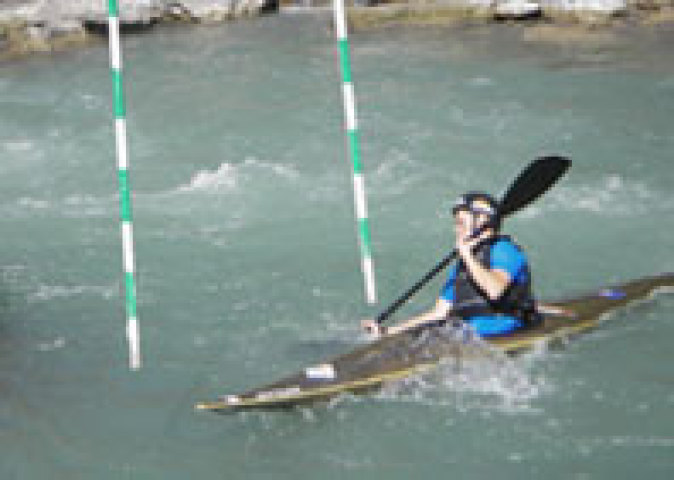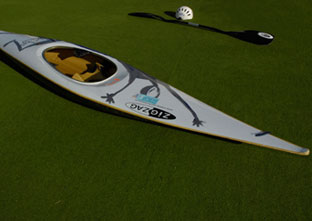
Athlete and machine as one
Unidentified Floating Object !
It has been a long time since we had sealskin stretched over a few sticks of driftwood… Today, looking closely at a competition slalom kayak, you cannot fail to be surprised by the amazing shape of an outboard at the front and a windsurf board at the rear. A novice senses it straight away: such a shape is certainly not by chance … “A good slalom kayak is designed above all to turn! It must be possible for it to virtually pivot on the spot with a single stroke of the paddle, explains Jean-Marc Lejot, the logistician in charge of the nautical equipment of the Fédération française de Canoë-Kayak (FFCK).
The front is sharp so that it slips easily into the wave, the middle must have enough volume to take the kayaker and, finally, the rear is flat so that it can pass underneath the gates of the slalom. I must admit, this gives the boats a very strange appearance…”

The revolution in plastic and composite materials
 These shapes, so surprising but so decisive for performance, would never have seen the light of day without the evolution of boat-building materials and techniques. “Plastics and composites entered our sport a good many years ago. In the 60s, small polyester boats were already making their appearance. It was a genuine revolution because this economical manufacturing process allowed the emergence and democratisation of canoes and kayaks. It was a first step…
These shapes, so surprising but so decisive for performance, would never have seen the light of day without the evolution of boat-building materials and techniques. “Plastics and composites entered our sport a good many years ago. In the 60s, small polyester boats were already making their appearance. It was a genuine revolution because this economical manufacturing process allowed the emergence and democratisation of canoes and kayaks. It was a first step…
A few years later, polyethylene models came out allowing large-scale manufacture. Whilst this technique is still used for models for the general public, due to its low cost and the strength of the boats, it is no longer used for competitors. Their boats are now made of a PVC/epoxy sandwich.”
 Apart from the weight advantage and the fineness of the work (the material is only placed where it is needed and nowhere else), these materials give the boats great rigidity. Kayakers and their boat really are as one.
Apart from the weight advantage and the fineness of the work (the material is only placed where it is needed and nowhere else), these materials give the boats great rigidity. Kayakers and their boat really are as one.
It should be noted in passing that this revolution in composite materials is not exclusively confined to nautical sports.
Tennis, skiing, golf, mechanical sports… they are all major users, for the same reasons.
And this is just the beginning !
“Certainly, the development of components is quite striking, but I think we can still do better”, continues Jean-Marc Lejot. “The next challenge concerns the hull/deck joints. At present these parts are made separately and joined together by polymerisation (gluing). To gain more rigidity, and therefore improve performance, we are trying to develop processes allowing boats to be made in one piece.”

Even the rocks are plastic
 For a long time now, plastics and composite materials have been essential in the world of nautical competition and not only in boats and their accessories (paddles, helmets, spray skirts, etc.) In effect, have you noticed that even the rocks strewn along a slalom course are also made of plastic?
For a long time now, plastics and composite materials have been essential in the world of nautical competition and not only in boats and their accessories (paddles, helmets, spray skirts, etc.) In effect, have you noticed that even the rocks strewn along a slalom course are also made of plastic?
“Today, these courses are very often created in one piece in sloping basins which have to be adapted by installing obstacles make the course tougher. These have to be realistic and we have found plastic to be the best material for artificial rocks: it is light, easy to transport, reassuring and fairly cheap…”
MORE INFORMATION





